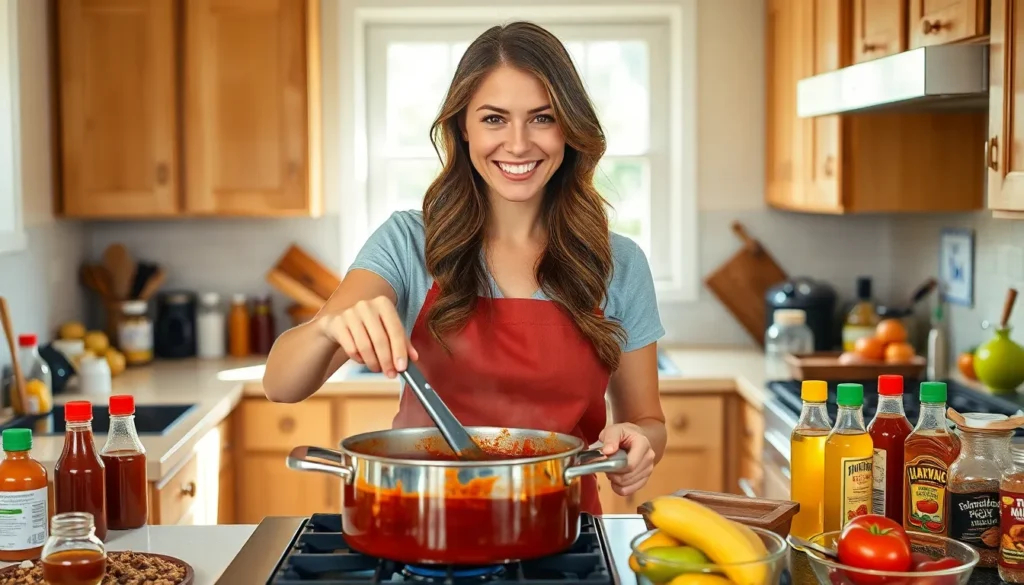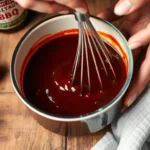There’s nothing quite like the smoky-sweet flavor of homemade BBQ sauce to transform your grilling game. While store-bought bottles line grocery shelves we’ve discovered that crafting your own sauce delivers unmatched depth and allows you to control every ingredient that hits your taste buds.
The beauty of homemade BBQ sauce lies in its versatility and simplicity. With just a handful of pantry staples you can create a sauce that’s perfectly balanced to your preferences – whether you crave tangy vinegar notes bold molasses sweetness or a kick of heat that builds with each bite.
We’ll walk you through our foolproof method that takes less than 30 minutes from start to finish. This recipe creates a rich glossy sauce that clings beautifully to ribs chicken and pulled pork while adding that signature BBQ flavor that’ll have your neighbors asking for your secret. Once you taste the difference you’ll never reach for store-bought again.
Ingredients
Creating the perfect BBQ sauce starts with selecting quality ingredients that work together to build layers of flavor. Our recipe uses pantry staples that you likely already have on hand.
Base Ingredients
- 1 cup ketchup
- 1/2 cup apple cider vinegar
- 1/4 cup water
- 2 tablespoons Worcestershire sauce
- 1 tablespoon yellow mustard
- 1 tablespoon tomato paste
Sweeteners
- 1/4 cup brown sugar (packed)
- 2 tablespoons honey
- 1 tablespoon molasses
Spices and Seasonings
- 2 teaspoons smoked paprika
- 1 teaspoon garlic powder
- 1 teaspoon onion powder
- 1/2 teaspoon black pepper (freshly ground)
- 1/2 teaspoon salt
- 1/4 teaspoon cayenne pepper
Optional Add-ins
- 1 tablespoon bourbon whiskey
- 1 teaspoon liquid smoke
- 1 tablespoon soy sauce
- 1 chipotle pepper in adobo sauce (minced)
- 1 teaspoon hot sauce
- 2 cloves fresh garlic (minced)
- 1 tablespoon butter (for richness)
Equipment Needed
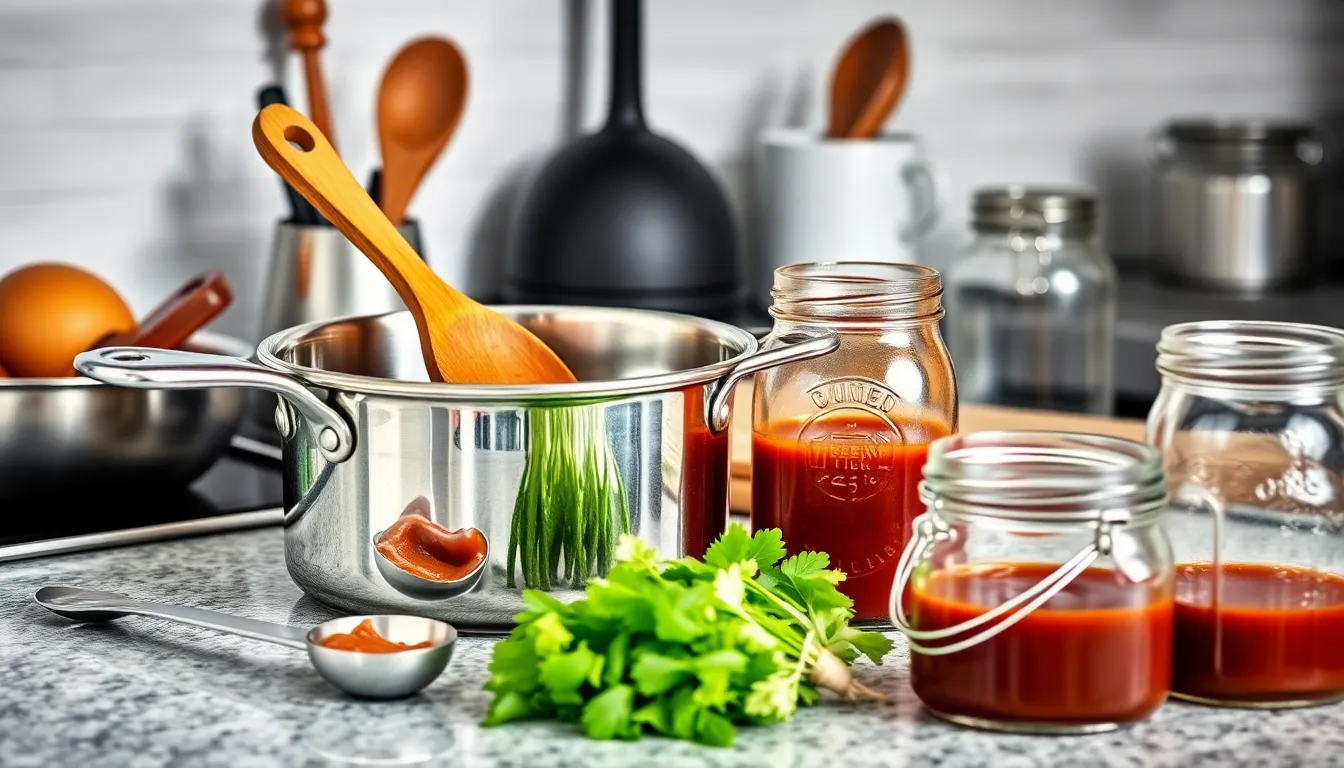
Creating our homemade BBQ sauce requires minimal kitchen equipment that most home cooks already have on hand. We need just a few essential tools to transform our ingredients into that perfect smoky and tangy sauce.
Saucepan or Large Pot serves as our primary cooking vessel for combining and heating all ingredients. We recommend using a medium to large sized pan to prevent overflow when the sauce begins to bubble and simmer.
Measuring Cups and Spoons ensure accuracy when portioning our ingredients. Precise measurements make the difference between a balanced sauce and one that leans too heavily toward sweet or tangy flavors.
Wooden Spoon or Whisk keeps our sauce moving during the cooking process. We prefer wooden spoons because they won’t scratch non-stick surfaces and handle heat well during extended stirring sessions.
Blender offers an optional step for achieving ultra-smooth texture. We can blend ingredients before cooking if we prefer a completely uniform consistency without any texture variations.
Jar or Airtight Container provides proper storage for our finished sauce. Mason jars work perfectly for refrigerator storage and allow us to see our beautiful homemade creation while keeping it fresh for up to three weeks.
This basic equipment setup allows us to create restaurant-quality BBQ sauce in our own kitchen without investing in specialized tools or gadgets.
Instructions
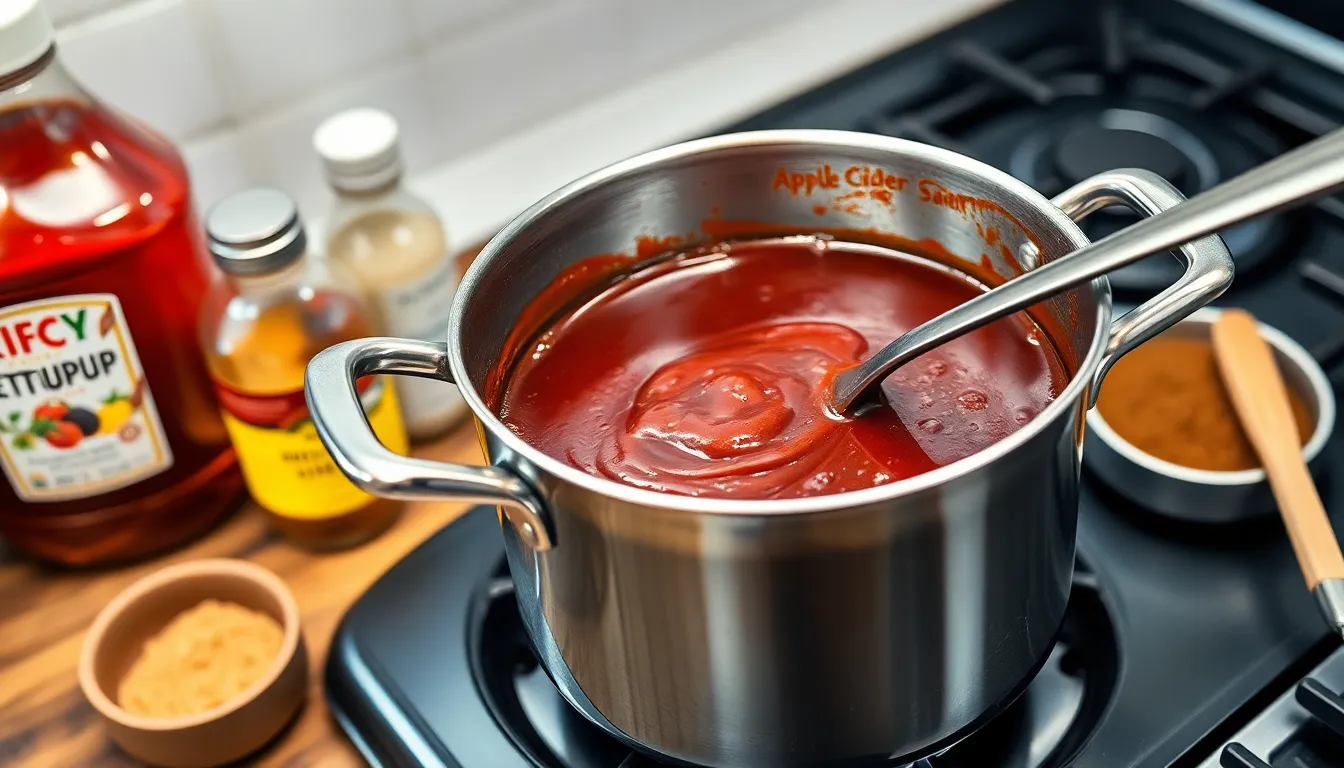
Making our homemade BBQ sauce involves five simple steps that transform basic pantry ingredients into a rich flavorful condiment. We’ll walk through each phase to ensure your sauce achieves the perfect balance of sweet tangy and smoky flavors.
Prep the Base
We start by gathering our main ingredients to create the foundation of our BBQ sauce. Measure out 1 to 2 cups of ketchup as our primary base along with 1/2 cup of apple cider or red wine vinegar. Add 1/2 cup of water to achieve the proper consistency and have 1 to 4 tablespoons of Worcestershire sauce ready for depth of flavor.
Combine Wet Ingredients
Pour the ketchup into your saucepan first followed by the vinegar and water. Add the Worcestershire sauce and stir the mixture thoroughly to combine all wet ingredients. For additional sweetness we incorporate 1/4 to 3/4 cup of brown sugar at this stage. Optional additions like honey or molasses can be mixed in now if desired for extra complexity.
Add Dry Seasonings
Stir in 1 to 2 tablespoons of yellow mustard or Dijon mustard for tanginess. Sprinkle in about 1 teaspoon of smoked or regular paprika to add depth and color to our sauce. Season with salt and pepper to taste then add optional spices like 1/4 teaspoon each of garlic powder and onion powder. For heat lovers we recommend adding 1/8 teaspoon of cayenne pepper or a few dashes of hot sauce.
Simmer and Thicken
Place the saucepan over medium heat and bring the mixture to a gentle simmer. Cook for approximately 5 minutes while stirring frequently to prevent sticking. This simmering process helps thicken the sauce naturally and allows all flavors to meld together beautifully. The sauce will reduce slightly and develop a richer consistency during this cooking phase.
Adjust Seasoning to Taste
Taste our BBQ sauce carefully and make final adjustments to achieve your preferred flavor profile. Add more brown sugar if you want additional sweetness or increase the vinegar for extra tang. We can boost the heat with more cayenne pepper or enhance the smokiness with additional paprika. Continue adjusting until the sauce reaches your ideal balance of flavors.
Cooking Tips
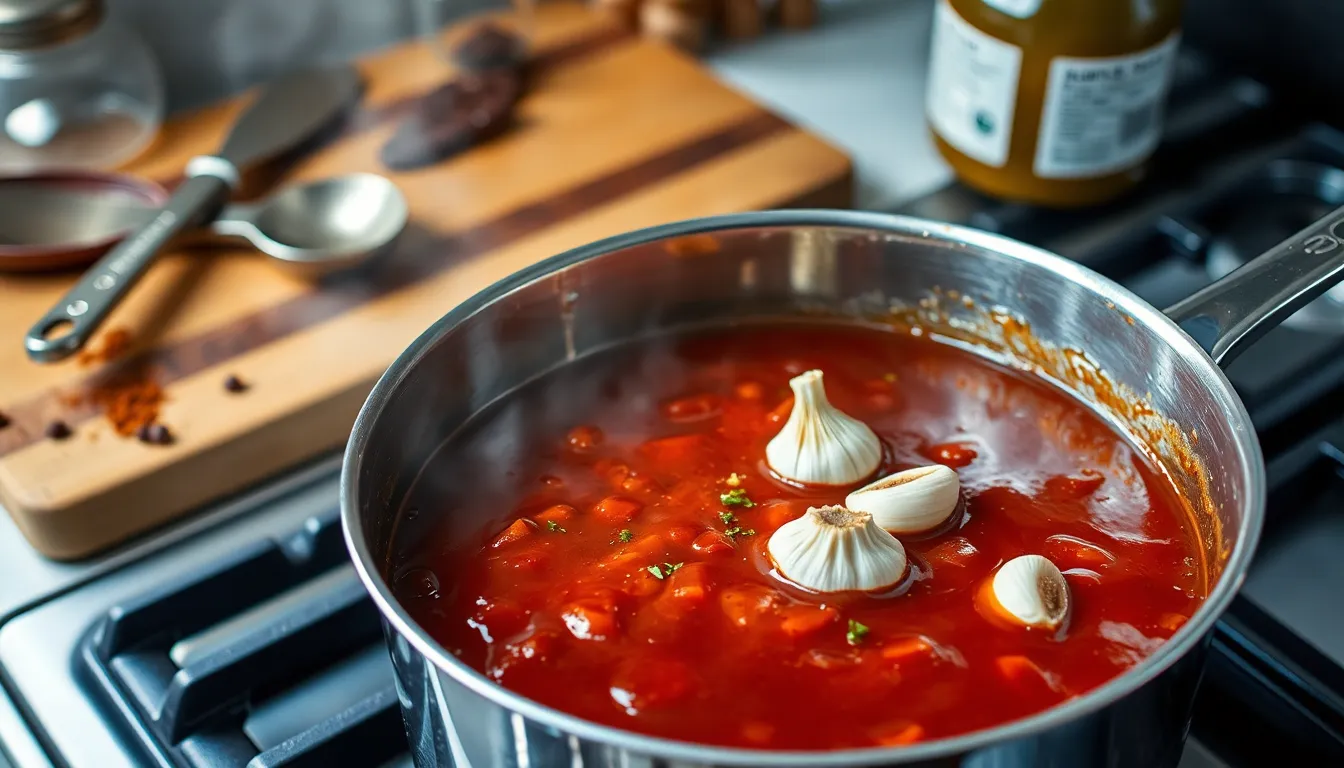
Perfect BBQ sauce requires mastering a few key techniques that transform basic ingredients into restaurant-quality condiment. These expert tips ensure your sauce achieves the ideal balance every time.
Heat Level Control
We recommend starting with minimal spicy ingredients and building heat gradually to avoid overpowering your sauce. Add hot sauce, cayenne pepper, or chipotle peppers in small increments while tasting between additions.
For mild sauces, we omit hot peppers entirely or use just a pinch of cayenne for subtle warmth. Medium heat lovers should add 1-2 teaspoons of hot sauce or ¼ teaspoon cayenne pepper. Spicy sauce enthusiasts can incorporate 1-2 tablespoons of hot sauce or ½ teaspoon cayenne pepper.
Fresh garlic adds natural heat that builds complexity without harsh bite. We suggest mincing 2-3 cloves for medium heat or up to 5 cloves for bold flavor profiles.
Consistency Adjustments
Achieving the perfect thickness requires patience during the simmering process. We simmer our sauce uncovered for 10-30 minutes, stirring occasionally to prevent sticking and burning.
Thicker sauces develop through longer cooking times that reduce liquid content naturally. Continue simmering until the sauce coats the back of a wooden spoon for ideal barbecue consistency.
Thin sauces benefit from gradual additions of water or vinegar during cooking. We add liquid one tablespoon at a time until reaching desired consistency. Overly thick sauces can be rescued by whisking in warm water off the heat.
For ultra-smooth texture, we blend the finished sauce using an immersion blender or regular blender after cooling slightly.
Flavor Balance
Master BBQ sauce makers understand that balance creates memorable taste experiences. We achieve this through careful adjustment of sweet, acidic, salty, and umami elements.
Sweetness comes primarily from brown sugar, honey, or molasses. We taste after initial simmering and add more brown sugar one tablespoon at a time for enhanced sweetness. Acidity from apple cider vinegar cuts through richness and brightens overall flavor.
Worcestershire sauce provides essential umami depth that distinguishes homemade sauce from store-bought versions. We use 2-3 tablespoons as our baseline and adjust upward for more complex flavor.
Smoked paprika delivers authentic barbecue smokiness without requiring actual smoking equipment. Add liquid smoke sparingly – just ½ teaspoon transforms ordinary sauce into smoky perfection.
We recommend tasting and adjusting each element incrementally rather than making large changes. This methodical approach prevents overwhelming any single flavor component and ensures professional results.
Storage Instructions
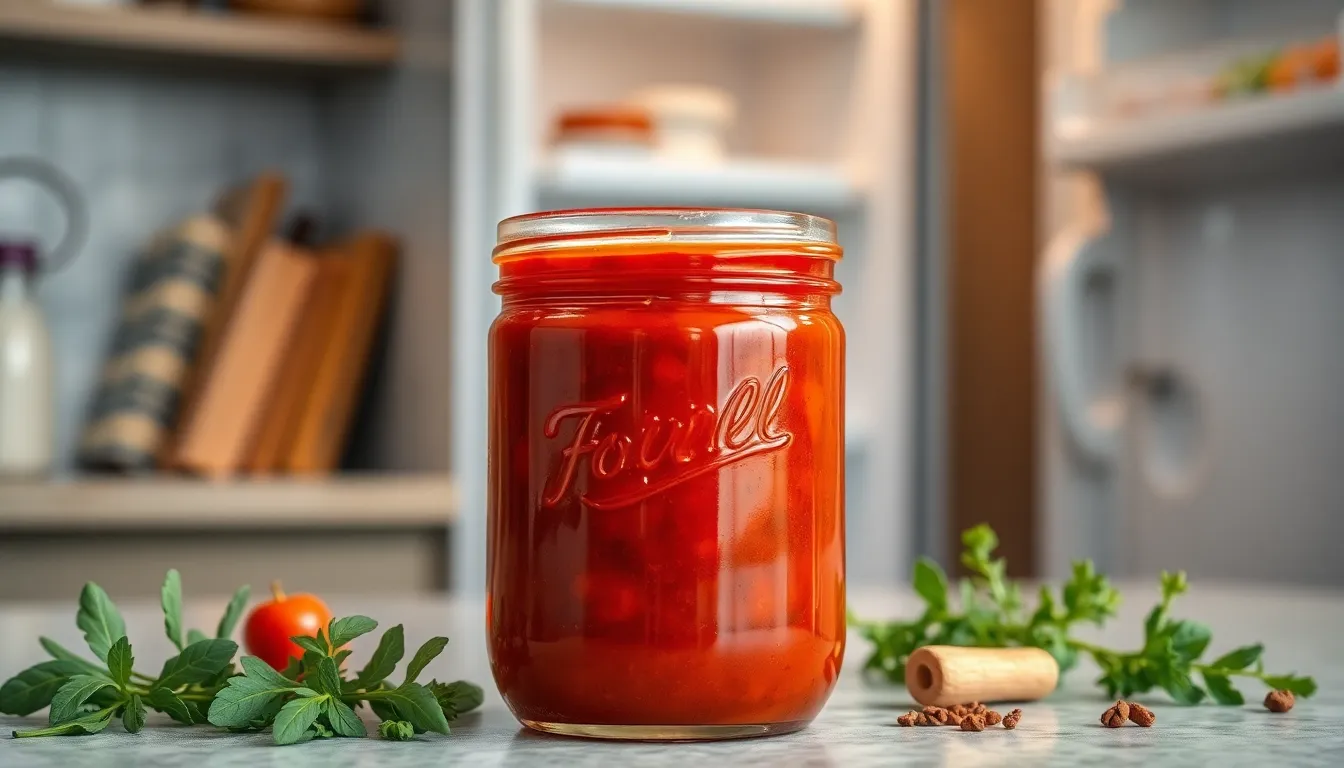
Once our delicious homemade BBQ sauce is ready, proper storage ensures we can enjoy its fresh flavor for weeks to come. Following these storage guidelines will maintain the sauce’s quality and safety.
Refrigerator Storage
We must allow the BBQ sauce to cool completely before transferring it to storage containers. Pour the cooled sauce into an airtight container or glass jar with a tight-fitting lid to prevent contamination and preserve flavor.
Store the sealed container in the refrigerator where it will maintain peak quality for up to 7 days. Some recipes with optimal ingredient quality and proper hygiene practices may extend this timeframe to 3 weeks.
Before each use, we should stir or shake the container well since natural ingredients tend to settle during storage. This simple step ensures even flavor distribution throughout the sauce.
Freezer Storage
For longer storage periods, we can freeze our homemade BBQ sauce for extended shelf life. Allow the sauce to cool fully before placing it in freezer-safe containers, leaving adequate space for expansion during freezing.
Our BBQ sauce will maintain excellent quality in the freezer for up to 3 months when properly stored. Label containers with the preparation date to track storage time effectively.
When ready to use frozen sauce, thaw it overnight in the refrigerator rather than at room temperature. Stir the thawed sauce thoroughly before serving, as separation may occur during the freezing and thawing process.
Serving Suggestions
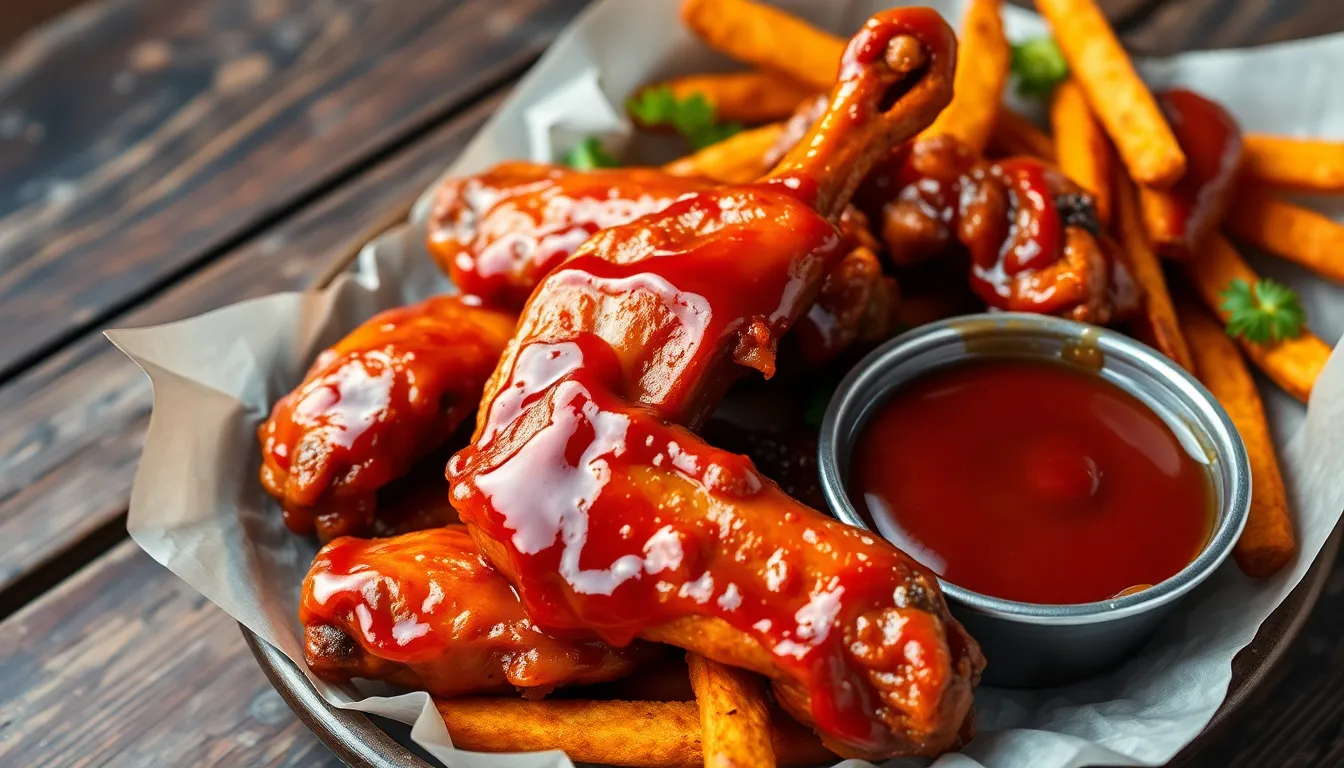
Our homemade BBQ sauce transforms ordinary meals into extraordinary culinary experiences. We recommend starting with traditional applications like brushing it over grilled chicken wings during the final minutes of cooking for that perfect caramelized glaze. Pulled pork becomes absolutely irresistible when tossed with generous amounts of our sauce before serving on brioche buns.
Ribs deserve special attention when using BBQ sauce. We suggest applying thin layers during the last 15 minutes of grilling to prevent burning while building up those coveted layers of flavor. The sauce creates a beautiful mahogany coating that seals in the meat’s natural juices.
Beyond classic barbecue applications, our sauce elevates vegetarian dishes remarkably well. Grilled tofu absorbs the smoky flavors beautifully when marinated for 30 minutes before cooking. Veggie burgers gain incredible depth when we brush the sauce on both sides during grilling.
Crispy foods pair exceptionally well with BBQ sauce as a dipping companion. Sweet potato fries become addictive when served alongside small bowls of our homemade sauce. Onion rings and regular fries also benefit from this flavorful pairing that beats any restaurant offering.
Roasted cauliflower creates an unexpected but delicious combination when tossed with our sauce after cooking. This preparation offers a healthier alternative to traditional buffalo cauliflower while delivering equally satisfying flavors. The sauce clings perfectly to the crispy edges of properly roasted vegetables.
BBQ jackfruit sandwiches showcase how versatile our sauce can be for plant-based meals. The meaty texture of jackfruit combined with our rich sauce creates convincing pulled pork alternatives that satisfy both vegetarians and meat lovers alike.
| Application | Cooking Method | Timing |
|---|---|---|
| Chicken Wings | Brush during grilling | Final 5-10 minutes |
| Ribs | Apply in layers | Last 15 minutes |
| Tofu | Marinate before cooking | 30 minutes |
| Vegetables | Toss after roasting | Immediately after cooking |
We encourage experimenting with unexpected pairings like drizzling the sauce over roasted Brussels sprouts or mixing it into coleslaw for added complexity. Pizza lovers can substitute our BBQ sauce for tomato sauce when making BBQ chicken pizzas at home.
Recipe Variations
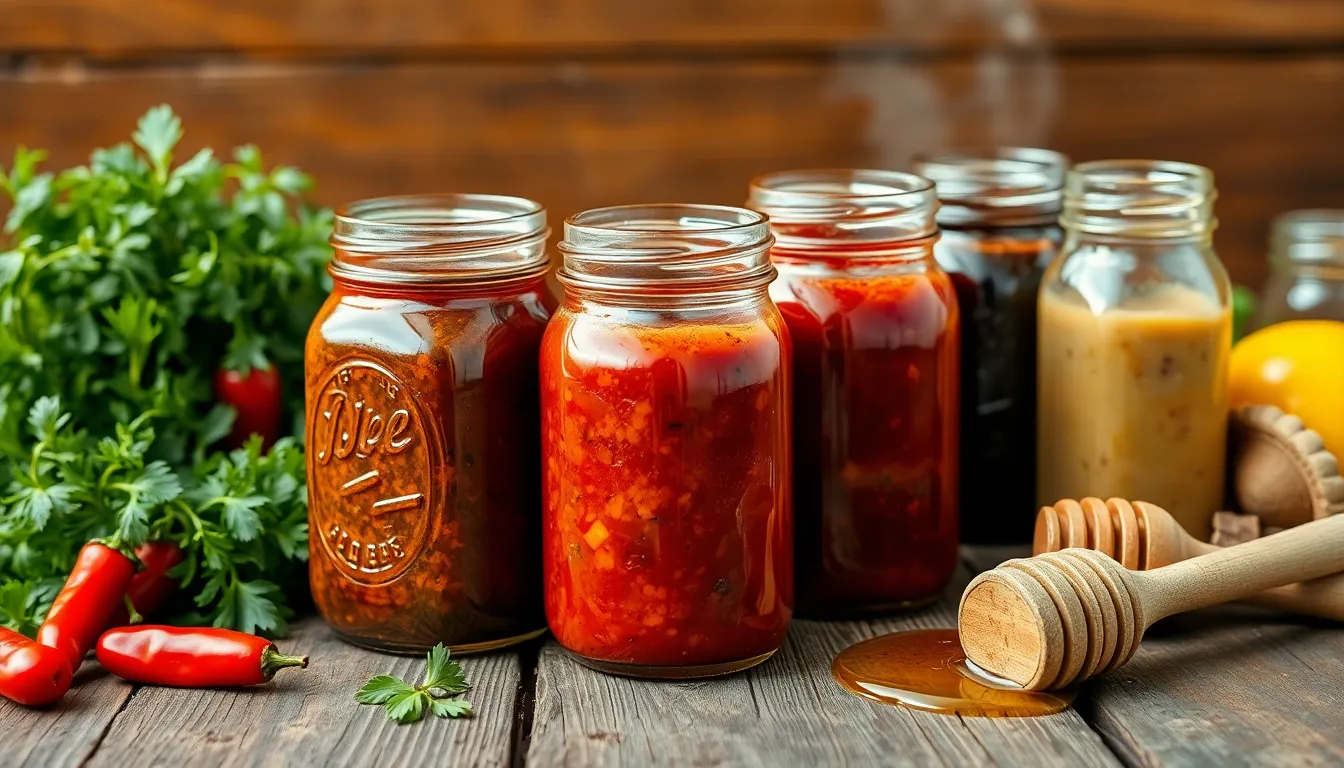
Our basic BBQ sauce recipe serves as the perfect foundation for creating diverse flavor profiles that cater to different taste preferences. Each variation builds upon the core ingredients while introducing unique elements that transform the sauce’s character completely.
Smoky BBQ Sauce
We enhance the base recipe with molasses and liquid smoke to create a rich, campfire-inspired flavor that pairs beautifully with beef brisket and pork ribs.
Ingredients:
- 1 cup ketchup
- ¼ cup apple cider vinegar
- ¼ cup molasses
- 2 tablespoons brown sugar
- 1 tablespoon Worcestershire sauce
- 1 tablespoon liquid smoke
- 1 teaspoon garlic powder
- 1 teaspoon onion powder
- Salt and pepper to taste
Instructions:
Combine all ingredients in a saucepan over medium heat. Simmer the mixture for 15 minutes while stirring occasionally until the sauce thickens to coat the back of a spoon. The molasses adds deep sweetness while the liquid smoke delivers authentic barbecue flavor without requiring an actual smoker.
Sweet and Tangy BBQ Sauce
This variation balances honey’s floral sweetness with vinegar’s sharp acidity to create our most versatile sauce option.
Ingredients:
- 1 cup ketchup
- ½ cup brown sugar
- ¼ cup apple cider vinegar
- 1 tablespoon honey
- 1 tablespoon Worcestershire sauce
- 1 teaspoon garlic powder
- Salt and pepper to taste
Instructions:
Simmer all ingredients together for 10 to 15 minutes until the sauce reaches your desired thickness. The honey integrates seamlessly during cooking while the brown sugar caramelizes slightly to add complexity. We recommend tasting after 10 minutes and adjusting the honey or vinegar ratio based on your preference.
Spicy BBQ Sauce
Heat lovers will appreciate this fiery variation that incorporates fresh peppers or dried spices to deliver customizable heat levels.
Basic Spicy Addition:
Add chopped habanero, jalapeño, or chili powder to taste to our base recipe.
Fruity Spicy Variation Ingredients:
- 1 cup mango (fresh or frozen)
- 1 to 2 habanero peppers (seeded for less heat)
- ½ cup ketchup
- ¼ cup apple cider vinegar
- ¼ cup honey
- 1 teaspoon garlic powder
- Salt and pepper to taste
Instructions:
Blend the mango and seeded habanero peppers until smooth before adding to the saucepan with remaining ingredients. Simmer for 10 to 15 minutes while stirring frequently to prevent sticking. The mango’s natural sweetness balances the habanero’s intense heat while creating a tropical flavor profile.
Mustard-Based BBQ Sauce
Our mustard-based variation offers a tangy alternative that’s particularly popular in South Carolina barbecue traditions.
Ingredients:
- 1 cup yellow mustard
- ¼ cup apple cider vinegar
- ¼ cup honey
- 2 tablespoons brown sugar
- 1 teaspoon Worcestershire sauce
- 1 teaspoon hot sauce
- Salt and pepper to taste
Instructions:
Simmer all ingredients for 10 minutes over medium-low heat to meld the flavors without breaking the mustard’s emulsion. This sauce works exceptionally well with pork shoulder and chicken thighs. The vinegar brightens the mustard’s natural tang while the honey and brown sugar provide necessary balance to prevent overwhelming sharpness.
Make-Ahead Instructions
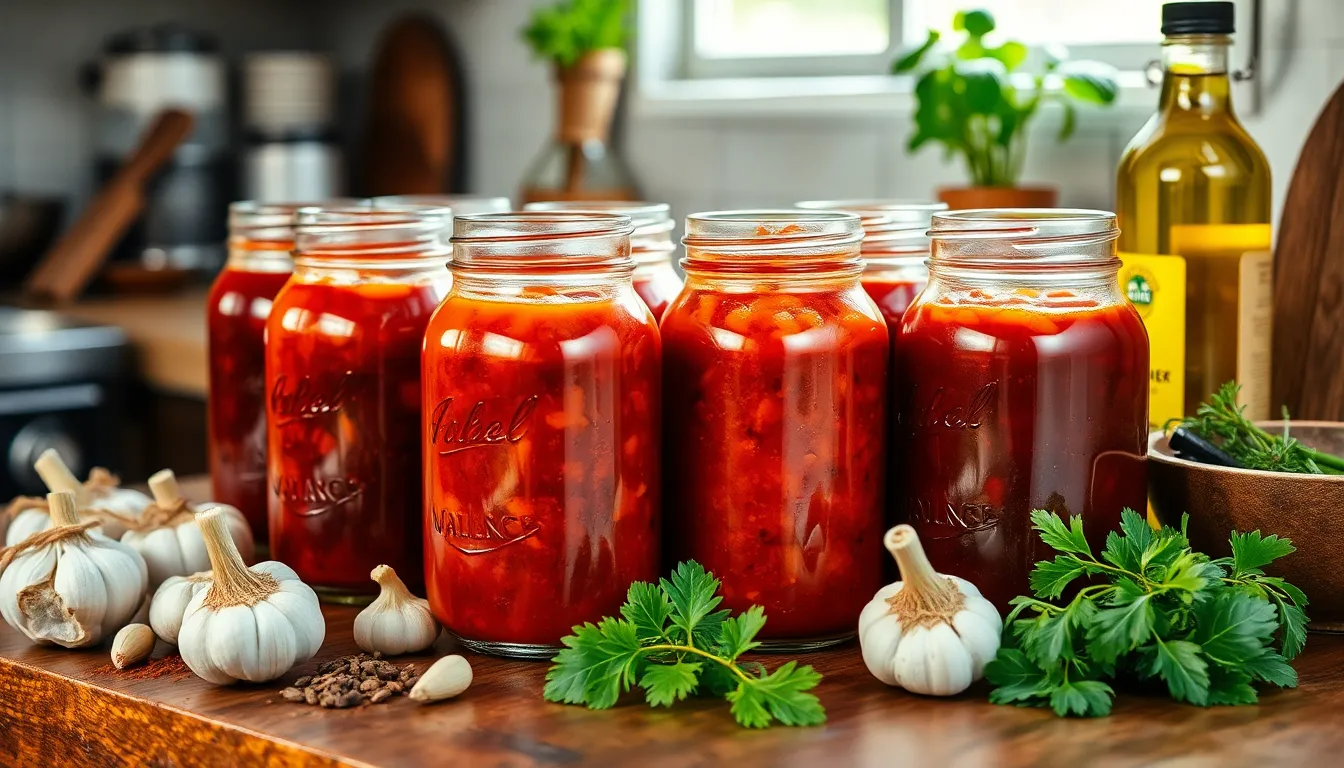
We highly recommend preparing this BBQ sauce ahead of time to maximize both convenience and flavor development. Our sauce can be made up to several days in advance and will actually improve in taste as the ingredients meld together.
Advance Preparation Timeline
The ideal timeline for make-ahead preparation allows at least 1 hour of resting time for basic flavor integration. For optimal results we suggest preparing the sauce overnight before serving. This extended resting period creates deeper flavor complexity and a more balanced taste profile.
Proper Cooling and Storage Process
Allow our freshly cooked BBQ sauce to cool completely at room temperature before transferring to storage containers. We recommend using airtight glass jars or plastic containers to maintain freshness and prevent flavor absorption from other refrigerator items.
Once cooled our sauce stores safely in the refrigerator for up to 1 week using standard ingredients. High-quality ingredients and proper sterilization of containers can extend storage life up to 3 weeks. We always label containers with preparation dates to track freshness.
Freezing for Extended Storage
Our BBQ sauce freezes exceptionally well for longer storage needs. Transfer cooled sauce to freezer-safe containers leaving about 1 inch of headspace for expansion. Properly frozen sauce maintains quality for up to 3 months without important flavor loss.
When ready to use frozen sauce we recommend thawing overnight in the refrigerator. Gentle stirring helps redistribute any separated ingredients and restores the original smooth consistency. We avoid microwave thawing as it can create hot spots that alter the sauce texture.
Flavor Enhancement Benefits
Making our sauce ahead provides important flavor advantages beyond mere convenience. The resting period allows acidic ingredients like vinegar to mellow while spices fully integrate throughout the mixture. Sweet components like brown sugar and honey also distribute more evenly creating a more harmonious taste.
We often notice that day-old sauce requires less seasoning adjustment than freshly made versions. This natural flavor development saves time during final meal preparation while delivering superior taste results.
Troubleshooting Common Issues
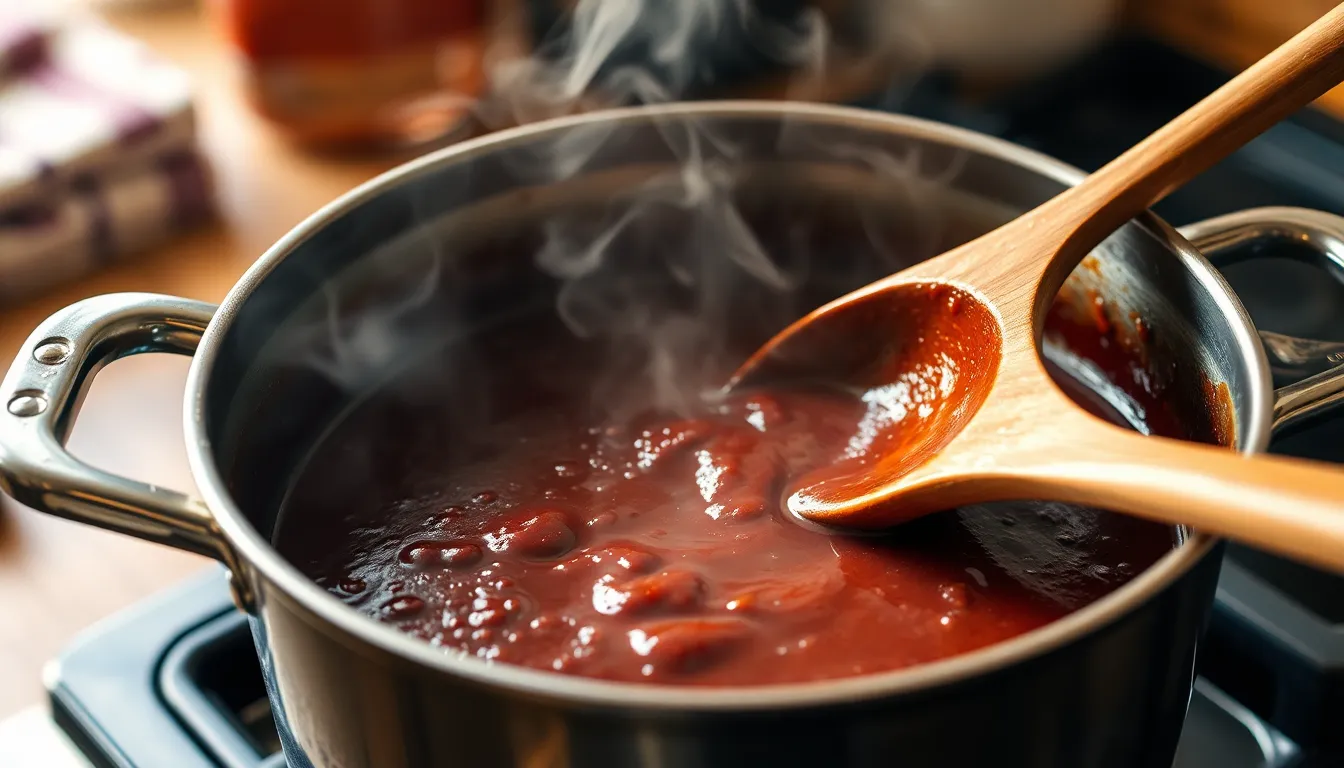
Even experienced cooks encounter problems when making BBQ sauce. We’ve identified the most common issues and their answers to help you create perfect sauce every time.
Gritty Texture from Brown Sugar
Brown sugar creates an unpleasant grainy texture when it doesn’t fully dissolve during cooking. This problem typically occurs when we add too much brown sugar early in the cooking process or when the heat is too high.
Solution: Add brown sugar after the initial simmering phase and whisk continuously as the sauce cools. The residual heat will dissolve any remaining grit while preventing the sugar from burning. We recommend switching to molasses-based recipes if you consistently experience this issue since molasses dissolves more readily than granulated brown sugar.
Sauce Too Sweet
Overly sweet BBQ sauce lacks the complexity that makes homemade versions superior to store-bought options. This imbalance typically results from using too much honey, brown sugar, or molasses without adequate acidic components.
Balance the sweetness by adding acidity through lemon juice, lime juice, or white vinegar. These additions cut through the sugar without significantly thinning the sauce consistency. We suggest starting with one tablespoon of acid and tasting before adding more.
Alternative solution: Add 1/4 to 1/2 teaspoon of powdered citric acid for a more concentrated acidic punch that won’t affect the sauce’s thickness. This method works particularly well when you need substantial sweetness reduction without diluting the overall flavor profile.
Sauce Too Ketchup-y or Bland
BBQ sauce that tastes overwhelmingly of ketchup lacks the depth and complexity we expect from homemade versions. This bland flavor profile indicates insufficient seasoning and umami development.
Boost umami flavors by adding Worcestershire sauce or a small sprinkle of MSG for immediate depth enhancement. These ingredients add savory complexity without overwhelming other flavors.
Enhance complexity by adjusting seasonings like yellow mustard, Dijon mustard, or smoked paprika. Start with small amounts and build gradually since these flavors intensify during the resting period.
Sauce Not Thick Enough
Thin BBQ sauce won’t properly coat meats or vegetables and creates a watery finish that diminishes the eating experience. This consistency issue typically stems from insufficient cooking time or too much liquid in the initial mixture.
Primary solution: Continue simmering the sauce to reduce liquid content and achieve proper thickness. The evaporation process concentrates flavors while creating the syrupy consistency we want.
Secondary technique: Add sugar late in the cooking process to help achieve the desired syrupy texture. Sugar contributes to thickening while improving the sauce’s glossy appearance.
| Issue | Primary Cause | Quick Fix | Prevention |
|---|---|---|---|
| Gritty texture | Undissolved brown sugar | Add sugar after simmering | Use molasses instead |
| Too sweet | Excess sweeteners | Add lemon/lime juice | Balance with vinegar |
| Bland flavor | Insufficient seasoning | Add Worcestershire sauce | Include umami ingredients |
| Too thin | Insufficient cooking | Simmer longer | Reduce initial liquid |
Additional Troubleshooting Tips
We recommend avoiding liquid smoke if you prefer fresh-tasting sauce over artificial smokiness. The chemical flavor can overpower other carefully balanced elements in your homemade creation.
Experiment with different vinegar types like apple cider versus red wine vinegar to find your preferred flavor balance. Each vinegar contributes unique flavor notes that complement different sweetener combinations.
Remember that flavor issues often resolve themselves during the overnight resting period as ingredients continue to meld and develop complexity.
Conclusion
We’ve shown you how to create restaurant-quality BBQ sauce right in your own kitchen with just a few simple ingredients and techniques. The beauty of homemade sauce lies in your ability to control every flavor element and create something that perfectly matches your taste preferences.
Whether you’re grilling this weekend or meal-prepping for the week ahead we know this sauce will become a staple in your kitchen. The versatility alone makes it worth the minimal effort – from traditional barbecue applications to creative uses you might never have considered.
Remember that great BBQ sauce gets better with time so don’t hesitate to make a batch in advance. Your taste buds (and your guests) will thank you for taking the homemade route over store-bought alternatives.
Frequently Asked Questions
How long does homemade BBQ sauce last in the refrigerator?
Homemade BBQ sauce can last up to 7 days in the refrigerator when stored in airtight containers. With optimal ingredient quality, it may last up to 3 weeks. For longer storage, freeze the sauce for up to 3 months. Always allow the sauce to cool completely before storing and label containers with the preparation date for freshness tracking.
What are the essential ingredients needed for BBQ sauce?
The essential ingredients include ketchup as the base, apple cider vinegar, water, Worcestershire sauce, yellow mustard, and tomato paste. Sweeteners like brown sugar, honey, and molasses add depth. Key spices include smoked paprika, garlic powder, onion powder, black pepper, salt, and cayenne pepper. Optional add-ins like bourbon, liquid smoke, or chipotle peppers can enhance flavor further.
How long does it take to make homemade BBQ sauce?
Homemade BBQ sauce takes under 30 minutes to prepare from start to finish. The actual cooking time involves combining ingredients, bringing the mixture to a simmer, and cooking until it reaches the desired thickness. Most of this time is hands-off simmering, making it a quick and easy recipe for busy home cooks.
Can I customize the BBQ sauce to my taste preferences?
Yes, homemade BBQ sauce is highly customizable. You can adjust sweetness with honey or brown sugar, add heat with cayenne or chipotle peppers, increase tanginess with vinegar, or enhance smokiness with liquid smoke. The recipe serves as a base that you can modify to create tangy, sweet, spicy, or smoky variations according to your personal preferences.
What kitchen equipment do I need to make BBQ sauce?
You’ll need minimal equipment: a saucepan or large pot for cooking, measuring cups and spoons for accuracy, and a wooden spoon or whisk for stirring. An optional blender can create a smoother texture. For storage, use airtight containers or jars. This basic setup allows you to create restaurant-quality BBQ sauce without specialized tools.
Does the BBQ sauce taste better after resting?
Yes, BBQ sauce improves in flavor as ingredients meld together over time. Allow at least one hour of resting time, though overnight preparation yields optimal flavor complexity. The resting period allows spices to fully integrate and creates a more balanced, complex taste. This makes the sauce perfect for meal prep and advance preparation.
What should I do if my BBQ sauce is too thick or thin?
If your sauce is too thick, add small amounts of water or vinegar while simmering. If it’s too thin, continue simmering to reduce and concentrate the flavors until it reaches your desired consistency. The sauce will also thicken slightly as it cools, so consider this when determining the final texture during cooking.
How can I fix common BBQ sauce problems?
For gritty texture, dissolve brown sugar completely before adding other ingredients. If too sweet, add acidic components like vinegar or lemon juice. For bland flavor, enhance with Worcestershire sauce, soy sauce, or additional spices. If the sauce lacks depth, try adding umami-rich ingredients or allow more resting time for flavors to develop.
What foods pair best with homemade BBQ sauce?
BBQ sauce is versatile and works with grilled meats like chicken, pork, and beef. It’s excellent for pulled pork, chicken wings, and ribs. Vegetarian options include grilled tofu, roasted vegetables, and sweet potato fries. Creative applications include using it as a pizza base, drizzling over Brussels sprouts, or as a dipping sauce for various foods.
Can I make different variations of the basic BBQ sauce recipe?
Absolutely! Popular variations include Smoky BBQ Sauce with molasses and liquid smoke, Sweet and Tangy with extra honey and vinegar, Spicy BBQ with fresh peppers, and Mustard-Based BBQ popular in South Carolina. Each variation builds on the basic recipe with specific ingredient adjustments to create distinct flavor profiles for different preferences and regional styles.

